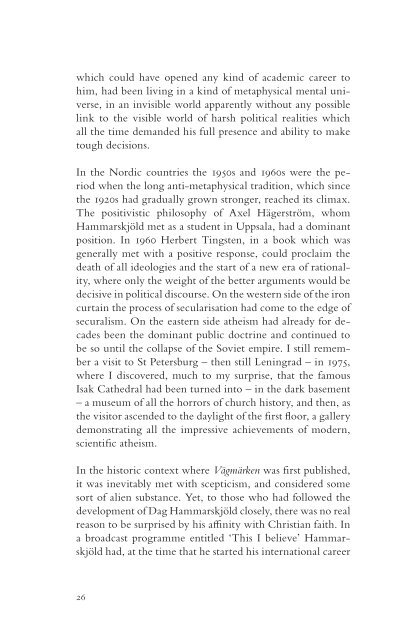Download as pdf - Dag Hammarskjöld Foundation
Download as pdf - Dag Hammarskjöld Foundation
Download as pdf - Dag Hammarskjöld Foundation
Create successful ePaper yourself
Turn your PDF publications into a flip-book with our unique Google optimized e-Paper software.
which could have opened any kind of academic career to<br />
him, had been living in a kind of metaphysical mental universe,<br />
in an invisible world apparently without any possible<br />
link to the visible world of harsh political realities which<br />
all the time demanded his full presence and ability to make<br />
tough decisions.<br />
In the Nordic countries the 1950s and 1960s were the period<br />
when the long anti-metaphysical tradition, which since<br />
the 1920s had gradually grown stronger, reached its climax.<br />
The positivistic philosophy of Axel Hägerström, whom<br />
<strong>Hammarskjöld</strong> met <strong>as</strong> a student in Uppsala, had a dominant<br />
position. In 1960 Herbert Tingsten, in a book which w<strong>as</strong><br />
generally met with a positive response, could proclaim the<br />
death of all ideologies and the start of a new era of rationality,<br />
where only the weight of the better arguments would be<br />
decisive in political discourse. On the western side of the iron<br />
curtain the process of secularisation had come to the edge of<br />
securalism. On the e<strong>as</strong>tern side atheism had already for decades<br />
been the dominant public doctrine and continued to<br />
be so until the collapse of the Soviet empire. I still remember<br />
a visit to St Petersburg – then still Leningrad – in 1975,<br />
where I discovered, much to my surprise, that the famous<br />
Isak Cathedral had been turned into – in the dark b<strong>as</strong>ement<br />
– a museum of all the horrors of church history, and then, <strong>as</strong><br />
the visitor <strong>as</strong>cended to the daylight of the first floor, a gallery<br />
demonstrating all the impressive achievements of modern,<br />
scientific atheism.<br />
In the historic context where Vägmärken w<strong>as</strong> first published,<br />
it w<strong>as</strong> inevitably met with scepticism, and considered some<br />
sort of alien substance. Yet, to those who had followed the<br />
development of <strong>Dag</strong> <strong>Hammarskjöld</strong> closely, there w<strong>as</strong> no real<br />
re<strong>as</strong>on to be surprised by his affinity with Christian faith. In<br />
a broadc<strong>as</strong>t programme entitled ‘This I believe’ <strong>Hammarskjöld</strong><br />
had, at the time that he started his international career<br />
26
















